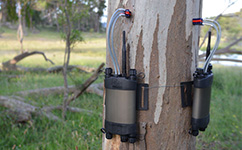Working principle: The plant stem flow is a new method for measuring Sap Flow invented by the French scholar Granier after the 1980s, namely the heat dissipation hot needle method (constant heat flow sensor method). The data acquisition of the method has the characteristics of being accurate and stable, and the data can be read continuously without interruption, and thus the data is systematic. The measuring system consists of a pair of 33mm long heat dissipating hot needles. During installation, the hot needles are inserted into the sapwood of the trees 10cm-15cm apart. The upper hot needle is wound around the resistance wire for DC heating, and the lower hot needle is not heated. Keep the same temperature as the surrounding sapwood tissue, and the temperature difference between the two hot needles reflects the liquid flow density of the trees.

In plant physiology, hydrological cycle and ground energy balance studies, water (transpiration) flowing through vegetation is a key research object. Plant water consumption is necessarily related to its growth and survival. In turn, the amount of water evaporated directly affects the process of vegetation formation associated with water availability. Therefore, researchers in many fields of application are very interested in the rate of plant water use. The zero point of the stem flow can be directly measured to eliminate the longitudinal temperature gradient of the stem, so that the precision is greatly improved.
The plant stem flow meter uses the constant heat flow sensor method, also known as the heat dissipation hot needle method, to measure the instantaneous stem flow density of the trunk. The liquid flow of the tree can be continuously observed for a long time, and the data can be read continuously and continuously, and the data collection is accurate and systematic. Plant stem flow measurement is conducive to studying the law of water exchange between trees and the atmosphere, and as a means of observation, long-term monitoring of the impact of forest ecosystems on environmental changes. Widely used in afforestation, forest management and forestry management and other units.
The working principle of the plant stem flow meter : http://?m=111&d=1511
The hot needle type stalk flow meter consists of a pair of 33mm long heat dissipating hot needles. When installing, insert the hot needles 10cm-15cm into the sapwood of the tree. The upper hot needle is wound around the resistance wire for heating under direct current. The needle is not heated and remains at the same temperature as the surrounding wood tissue, and the liquid flow density of the tree is reflected according to the temperature difference between the two hot needles.
The plant stem flow uses the TDP heat dissipation sensor principle and includes 4 hot needles. The first and second hot needles are inserted into different parts of the plant stem, and the upper hot needle is heated by a constant current, and a temperature difference is formed between the two hot needles. When the water flow rises, the heat is removed and the temperature difference between the two hot needles becomes smaller. There is a functional relationship between the temperature difference and the stem flow, and the stem flow is calculated by measuring the temperature difference. The third and fourth scalding needles measure the longitudinal temperature gradient of the stalk to modify the temperature difference between the first and second scalding needles.
The frequency of the ultrasonic energy meter is 1 megahertz (1 million Hz / s), the direction is accurate, and the penetration is strong. Through the three major effects of sound waves (mechanical, warm, physical and chemical effects) on various parts of the human body, to achieve the role of massage relaxation.
Ultrasound Treatment, Healthcare Ultrasound, Medical Ultrasound, Therapeutic Ultrasound
Shenzhen Guangyang Zhongkang Technology Co., Ltd. , https://www.nirlighttherapy.com